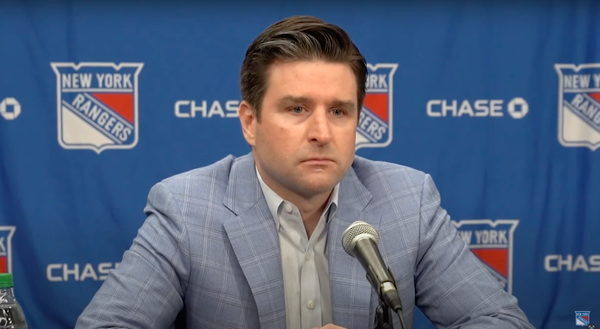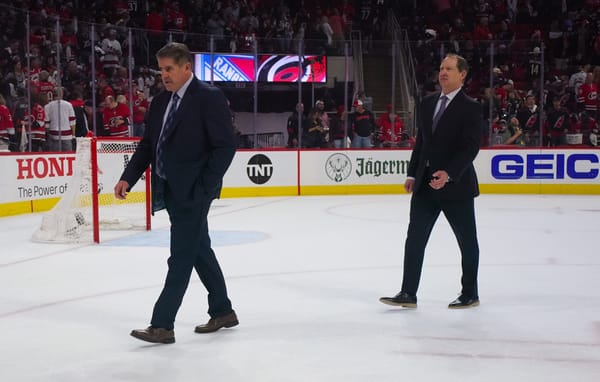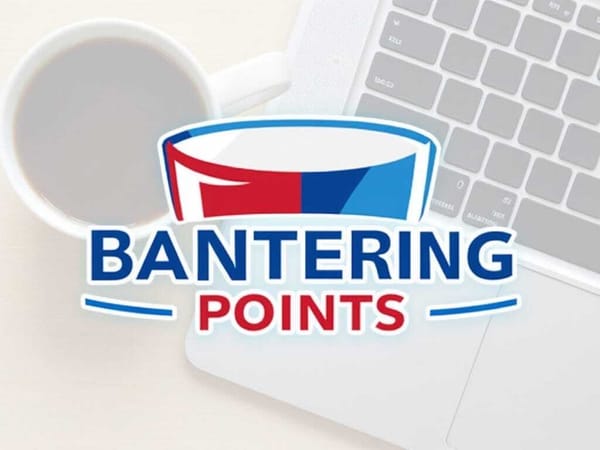New York Rangers Analysis: Rick Nash and Derick Brassard? It makes more sense than you might think
With Derek Stepan out, the Rangers will need to figure out their line combinations moving forward. But an old relationship could be the key to how Alain Vigneault approaches things.
The old saying goes, if it ain't broke, don't fix it. When it comes to the Rangers line combinations that at the surface meant not breaking up the trio of Rick Nash, Chris Kreider, and Derek Stepan. Of all the returners on Broadway this season, those three forwards constituted the only chance Alain Vigneault had at actually keeping a line together And on top of that, the line seemed to click rather well last season.
Top 20 most commonly used forward line combinations of this past season pic.twitter.com/TIcWFBCqlN
— Matt Pfeffer (@MattyPfeffer) September 18, 2014 Now obviously just because the three accounted for a significant amount of on-ice Corsi events together doesn't necessarily make them good. That also takes into account shot attempts against, which, without providing the differential, could really be slanted in one direction. But the numbers tell a more positive story, with all three players coming in with CF% above 50, and positive CorsiRels.
So when Stepan broke his fibula during on-ice testing earlier this week, conventional wisdom, to a point, almost said that while part of this equation was now broke, it wasn't in dire need of a major fix. There was an argument to be made about not putting the Rangers lineup in major flux, and simply promoting someone to fill the role for the nine or so games Stepan is expected to miss, like Dominic Moore.
 More on Stepan's Absence
More on Stepan's Absence 
 More on Stepan's Absence
More on Stepan's Absence 
There were others calling for a player like Derick Brassard to see those top line minutes, and some perhaps who were even suggesting Brassard and Nash begin the season on the same line before Stepan went down. The pair, along with Anthony Duclair, have skated exclusively on a line during preseason game situations, including the intrasquad scrimmage, and tonight's game in Chicago.
And when you look a little deeper at the numbers, Brassard-Nash might make sense for more reasons than you thought.
From the time Brassard was in Columbus, from the beginning of his rookie season in 2007 to when he was traded to the Rangers in 2013, he was predominately deployed in 5v5 situations with Nash. Likewise, one of Nash's most consistent linemates at evens over that same stretch was—you guessed it—Brassard.
Dan Parker of SB Nation's Blue Jackets blog The Cannon provided some more context to how this relationship played out.
My recollections are that there was a flash during Brassard's "full" rookie year (2008-09) where they played together and lit it up: Brassard had 10/15/25 in 31 games... and then he destroyed his shoulder in a pointless fight in Dallas and didn't play the rest of the season or playoffs. The following season, however, the Jackets had acquired Antoine Vermette and he sort of took over that top line center role from Brassard. At 5-on-5, they didn't play together all that much until the following two seasons ('10-'11, and '11-'12). Brassard was OK, with a combined 88 points in 148 games, but the feeling here (again, with no real "data" to back it up) was that playing with Nash held Brassard's overall offensive development back. He tended to defer to Nash at almost all times, and seemed content not to try to "get his" offensively. We always thought Brassard had a sneaky-good shot, but he just didn't shoot that much because he preferred to pull up and try to find Nash. He just seemed like a guy who tried to make the awesome set-up pass 99 times out of 100 instead of using the space Nash afforded to create his own offense.
Looking at how they played off of each other, Nash scored 122 5v5 goals over the four season he and Brassard were Blue Jackets teammates.
| Year | Nash Total 5v5 Goals | Brassard Primary Assist | Brassard Secondary Assist | Brassard Total Assist % |
| 2007-2008 | 24 | -- | -- | 0% |
| 2008-2009 | 29 | -- | -- | 0% |
| 2009-2010 | 21 | 0 | 1 | 5% |
| 2010-2011 | 26 | 7 | 1 | 31% |
| 2011-2012 | 22 | 2 | 1 | 14% |
| Total | 122 | 9 | 3 | 10% |
Those first few seasons could have essentially be eliminated, or at least some context should be added. In that first year, the pair skated only a little more than 28 even strength minutes together. In 08-09, that number jumped to over 74. The following season, it increased again to over 127. But in 10-11, when that hike in assist% occurs was when they really, truly were on a line together, playing over 581 5v5 minutes together. The year after, Nash's final season in Columbus, their ice time together dropped to just over 456 minutes together, still a significant number.
Nash has only played one full season since coming to New York, which was this past one. His most common even strength teammate was Stepan (even more so than Henrik Lundqvist, which is a bit odd), who played with Nash for a hair over 660 minutes. And of Nash's 26 goals even strength goals last season, Stepan's total assist% was 46.
During his tenure in Columbus, Nash was scoring more power play goals. The seven he's scored for the Rangers over a season-plus of games was a total number he eclipsed twice when he and Brassard were Blue Jackets teammates, and three seasons prior to that relationship as well.
Stepan has played more minutes with Nash in a single season than any of Nash's other teammates have ever. But looking back at Parker's assessments of the Nash-Brassard combo, and a few things jump out.
He tended to defer to Nash at almost all times, and seemed content not to try to "get his" offensively. We always thought Brassard had a sneaky-good shot, but he just didn't shoot that much because he preferred to pull up and try to find Nash. He just seemed like a guy who tried to make the awesome set-up pass 99 times out of 100 instead of using the space Nash afforded to create his own offense.
This a Brassard the Rangers know all too well, and a player whom they tried to get to come out of his shell a bit. Brassard was second on the Rangers in setup passes a year ago (passes that lead directly to shots), with only teammate Mats Zuccarello completing more. But down the stretch, and including the postseason, Brassard appeared more comfortable shooting the puck.
What it seems like is Brassard is simply a better overall player since he and Nash were last on a line together. Not only has his scoring touch come out and his offensive game blossomed in that regard, but Brassard also continued to be an effective passer, adding 27 assists (the second most he's ever posted) to his career-high 18 goals a year ago.
The short answer to this whole puzzle is this won't be an easy choice for Vigneault, and there won't be a right answer until one combination thrives, or one plan fails. Stepan may be the best option in the perfect scenario, but given what the Rangers are being faced with, maybe Brassard could provide the most total value if he and Nash begin on a line together right now.




